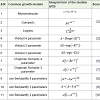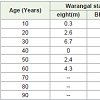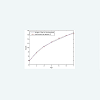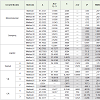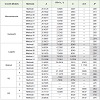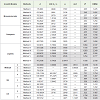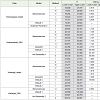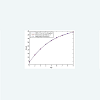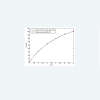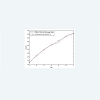Research article
A Comparative Study of Nonlinear Growth Models on Teak (Tectonagrandis L.) in India
Dimpal Jyoti Mahanta1* and Munindra Borah2
1Department of Mathematics, Assam Kaziranga University, Koraikhowa, Jorhat, Assam, India
2Department of mathematical sciences, Tezpur University, Tezpur, Assam, India
Corresponding author: Dimpal Jyoti Mahanta, Department of Mathematics, Assam Kaziranga University,Koraikhowa, Jorhat, India, Tel: 9854302519; E-mail: dimpal@tezu.ernet.in
Citation: Mahanta DJ, Borah M. A Comparative Study of Nonlinear Growth Models on Teak (Tectonagrandis L.) in India. J Plant Sci Res. 2017;4(1): 165.
Copyright © Mahanta DJ, et al. 2017. This is an open access article distributed under the Creative Commons Attribution License, which permits unrestricted use, distribution, and reproduction in any medium, provided the original work is properly cited.
Journal of Plant Science & Research | ISSN: 2349-2805 | Volume: 4, Issue: 1
Submission: 31/12/2016; Accepted: 18/03/2017; Published: 17/04/2017
Abstract
This study presents a comparative study of the most commonly used six growth models Monomolecular, Gompertz, Logistic, Weibull, Von Bertalanffy and Chapmen Richard growth models for describing the growth pattern of Teak (Tectonagrandis L.) in India. Various methods of estimation are introduced to estimate the parameters of above mentioned model. Four sets of well-established teak data of India have been used for testing the validity of the models. The best fit model has been selected based on a selection criterion. According to the results of our calculation, it can be concluded that, the three parameter monomolecular growth model is more reasonable over the remaining growth models to describe the growth of Teak in India.
Keywords: Growth model; Chapmen richards; Von bertalanffy; Logistic; Gompertz; Monomolecular; Weibull; Teak growth; Method of estimation
Introduction
Teak (Tectonagrandis L.) is an all-around premier species of many favorable properties and will remain as one of the most admiredand precious tree. Teak plant has a very economical importance as its wood is very durable, resistant to fungi. It is indigenous to only four countries namely India, Myanmar, Thailand and Lao People’s Democratic Republic [1]. In this study an attempt has been made to analyze the growth (height and Diameter at breast height) of Teak in India with the help of a set of suitable growth functions.
The Chapmen Richards growth model along with its limitingcases has a wide application in forestry. Here we consider five limiting cases namely Von Bertalanffy, Monomolecular, Logistic and Gompertz growth model. Various researchers have been used these models and Weibull growth model in forestry. This study presents a comparative study of these models to describe the growth pattern of Teak plant in India.
This paper is organized as follows, Section II gives an overview of the data and methodology for the estimations of the parameters of the model. In this paper we apply some new technique to estimate the parameters of Von Bertalanffy and Chapmen Richard growthmodels. The main advantages of the new techniques applied in this paper are less computation and can be used for any growth data. The parameters of Monomolecular, Logistic and Gompertz growth models are estimated using the technique used by Borah and Mahanta [2]. The generalized Newton Raphson technique used in Mahanta and Borah are applied to estimate the parameters of Weibull growth model [3].
In section III, we describe the selection criteria for selecting the best fit model. The selection criteria consist of six distinct steps.
The two final sections (section IV and V) include a brief analysisof the results and some of the main conclusions.
Materials and Methods
The integral forms of Monomolecular, Gompertz, Logistic, Weibull (two, three and four parameters), Von Bertalanffy (two, three and four parameters) and Chapmen Richard (three and four parameter) growth models are shown in Table 1. The data composed in the Table 2 are of height and DBH growth data from Teak trees in Warangal state and Hoshangabad division of India [1].
Table 2: Height and DBH growth data from Teak trees in Warangal state and Hoshangabad division of India.
Here A,B,K,d,β,b1,b and m are parameters to be estimated, y is the dependent growth variable, t is the independent variable and exp(e) is the base of the natural logarithms. The parameters of the growth models are defined as: A is the asymptote; K is the parameter governing the rate at which the regress and approaches its potential maximum; m is the allometric constant; d is the instant rate of growth in the inflection point, b is the value of the growth at the initial age and B, β and b1 are biological constants.
The different growth models can be written in the form as

i=1,2,....,n, where B is the vector of parameters bj (b1,b2...,bs) to be estimated, s is the number of parameter, n is the number of observations and εi’s are random errors in the models has mean zero and constant variance σ2. The following methods of estimation have been used to fit the growth models.
Method of Estimation
The parameters of Monomolecular, Logistic and Gompertz growth have been estimated using the technique used by Borah and Mahanta [2]. The generalized Newton Raphson technique used in Mahanta and Borah are applied to estimate the parameters of Weibull growth models [3]. The new methods for the estimation of the parameters of Von Bertalanffy and Chapmen Richard growth models are described as follows.
Methods to estimate the parameters of Chapmen Richards’sgrowth model
Fitting of the four parameters model
Method I: In this method, first assume that the parameter d is known from its definition. Assume n be the total number ofobservation and let ta,tb and tc are any three observations from the set of data. Then for i = a,b,c the Chapmen Richards growth model with four parameters can be written as

Now,

and

From the equation (3) and (4),

Where

The equation (5) can be solved using any iteration method, and then the parameter K can be estimated as,

After estimation of the parameter K; the parameters B, A and d can be estimated using the equations (2), (3) and (4). The required estimated parameters are given by



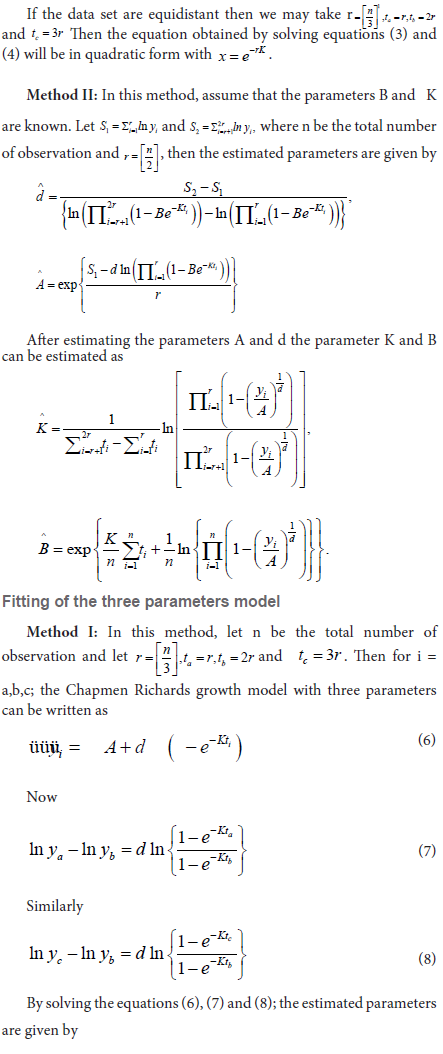
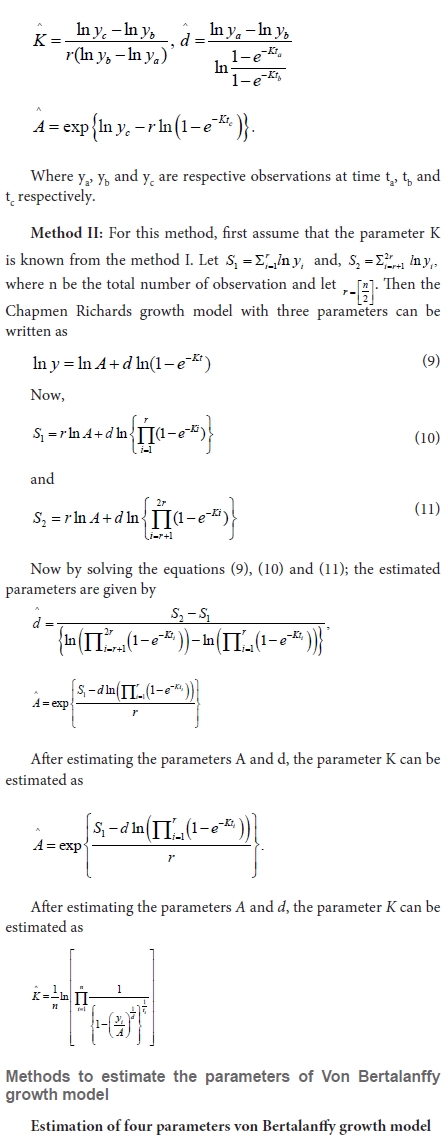
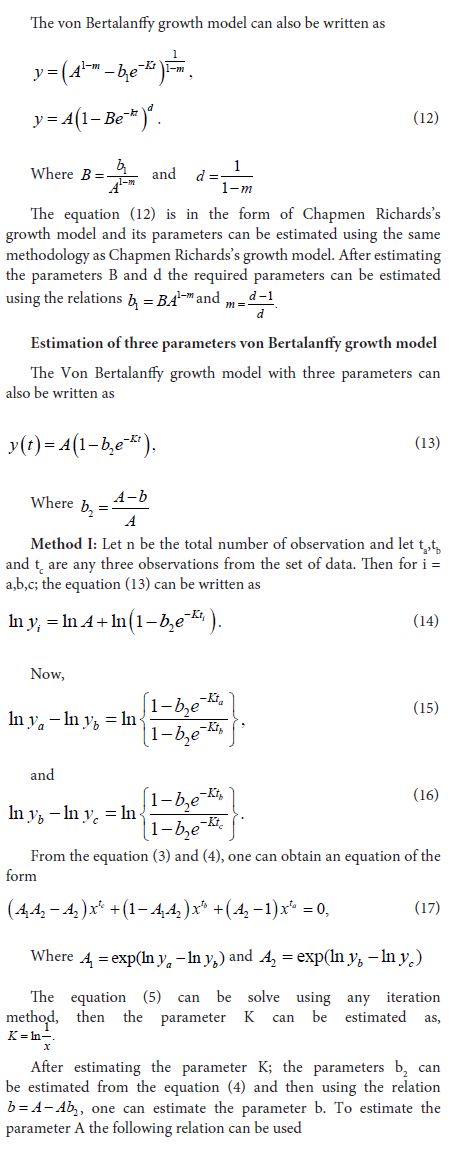
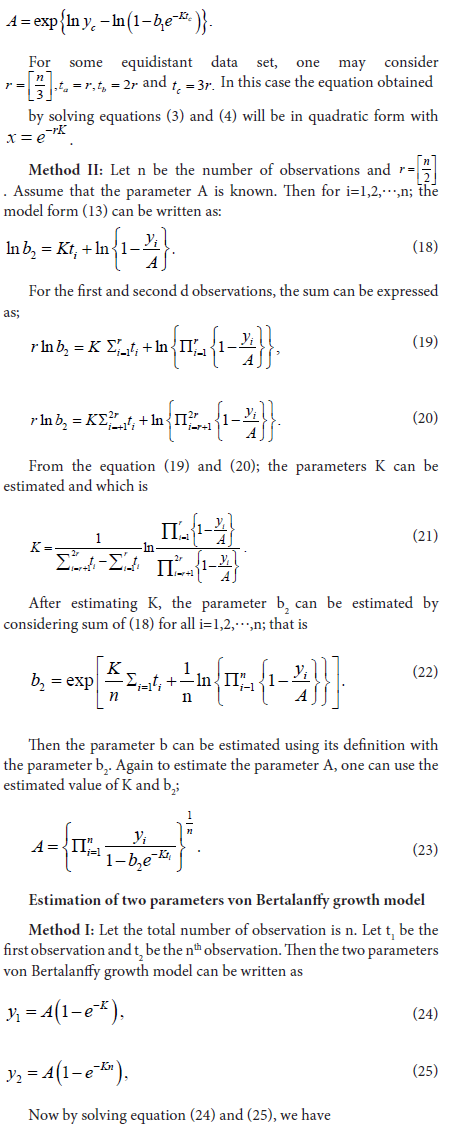
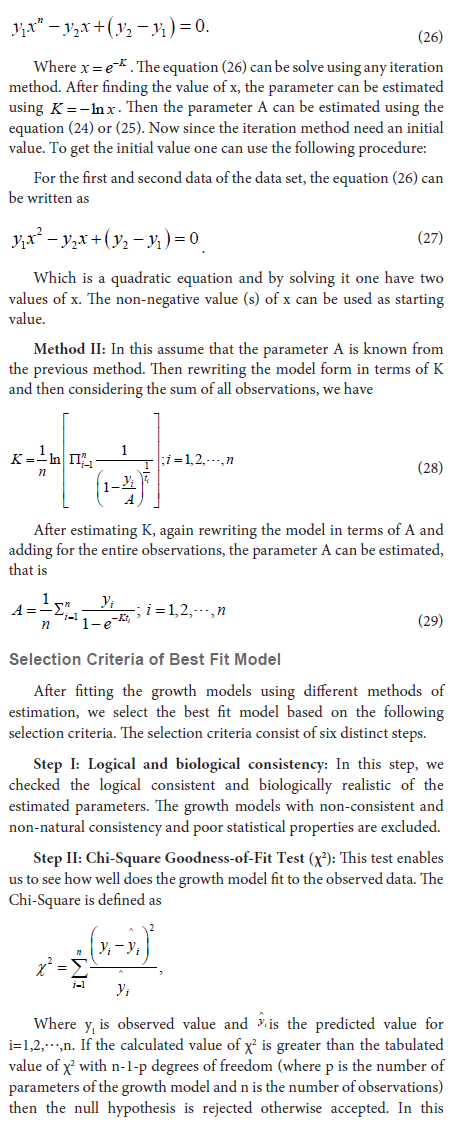
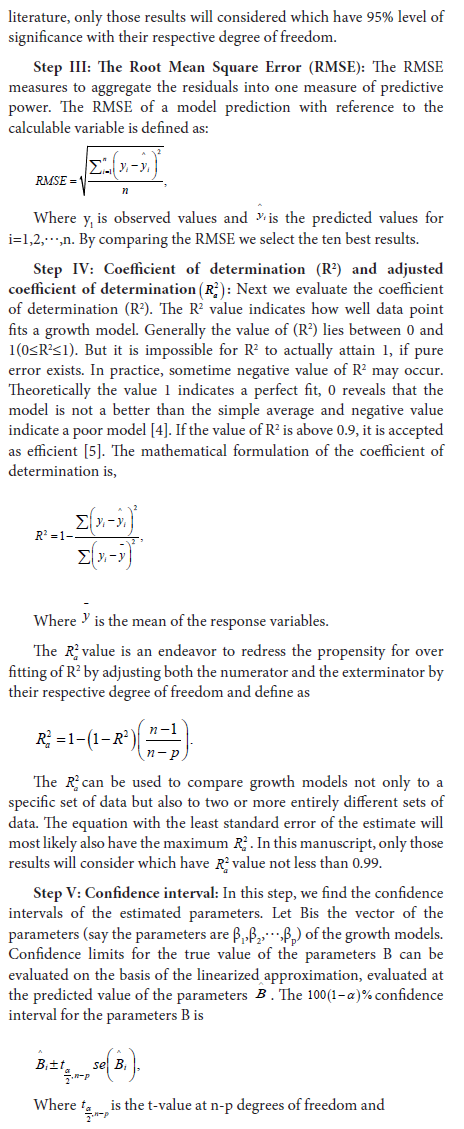
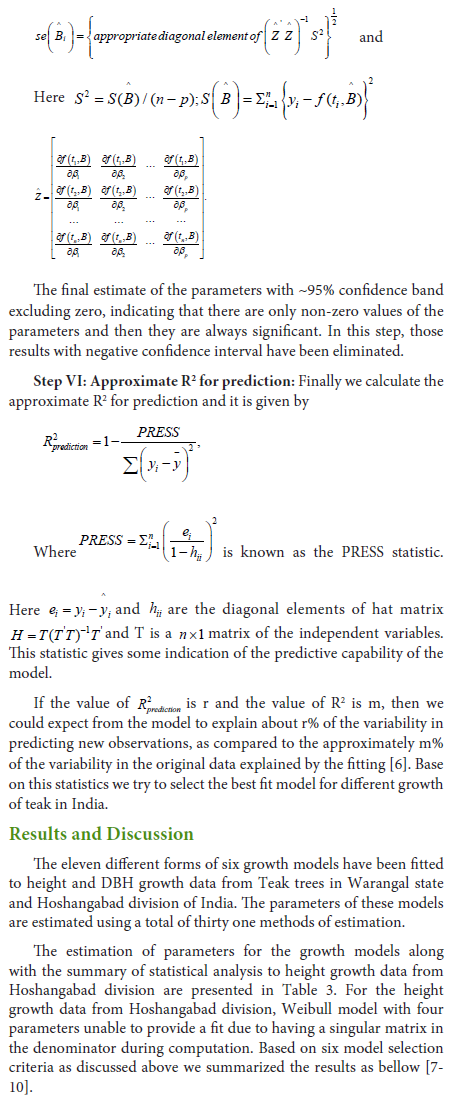
Table 3: Estimation of parameters along with the summary of statistical analysis to height growth data from Hoshangabad division.
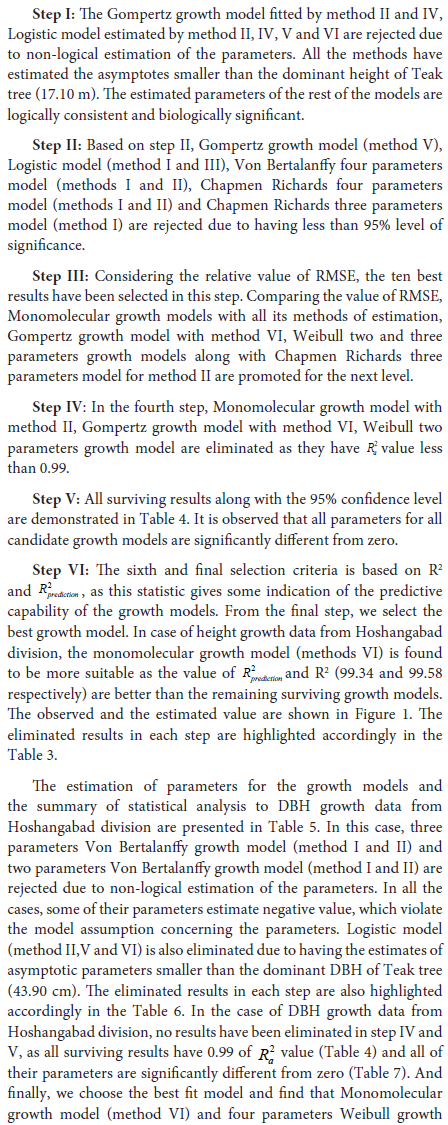
Table 4: Estimation of parameters along with the summary of statistical analysis to DBH growth data from Hoshangabad division.
Table 5: Estimation of parameters along with the summary of statistical analysis to height growth data from Warangal state.
Table 6: Estimation of parameters along with the summary of statistical analysis to DBH growth data from Warangal state.
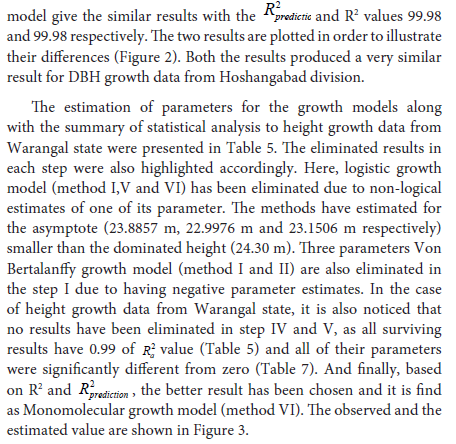
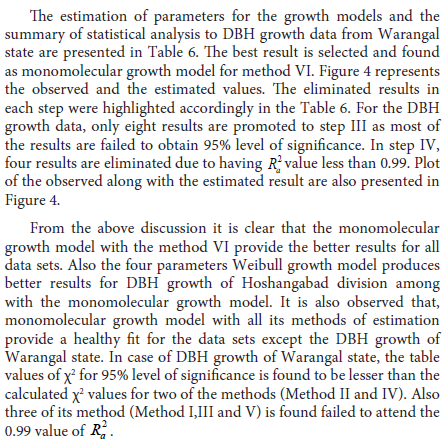
Conclusion
In this paper we summarize and attempt to find the best fitgrowth model along with the best method of estimation for the teak growth in India based on the available teak data. A specific selection criterion with six distinct steps has been considered to compare the results. According to the results, monomolecular growth model while estimated by method VI provides the better results for all data sets whereas four parameters Weibull growth model offer similar result for DBH growth of Hoshangabad division. By observing all the results, it can be concluded that, the monomolecular growth model is more reasonable over the remaining growth models for describing the growth of Teak in India. One may consider any method of estimation (From method I to method VI) to estimate the parameters of the monomolecular growth model but the method VI is more preferable.
References
- (2007) Gyi KK, Tint K (1998) Management status of natural teak forests. FAO, Reg Office Asia Pacific.
- Borah M, Mahanta DJ (2013) Rapid parameter estimation of three parameter nonlinear growth models. Int J Math Arch 4: 274-282.
- Mahanta DJ, Borah M (2014) Parameter estimation of Weibull growth models in forestry. Int J Math Trends Technol 8: 157-163.
- Soares P, Tome M, Skovsgaard JP, Vanclay JK (1995) Evaluating a growth model for forest management using continuous forest inventory data. For Ecol Manage 71: 251-265.
- Ozel HB, Karadavut U, Ertekin M (2010) The use of growth models in investigating oriental beech (Fagus orientalis Lipsky.) natural juvenitilies growth performance. Afr J Agric Res 5: 2544-2550.
- Myers RH, Montgomery DC, Vining GG, Robinson TJ (2012) Generalized linear models: with applications in engineering and the sciences, (2ndedn). A John Wiley & Sons Inc, New Jersey.
- Tjørve E (2009) Shapes and functions of species-area curves (II): a review of new models and parameterizations. J Biogeogr 36: 1435-1445.
- Colbert JJ, Michael S, Desta F, James R, Mairtin M, et al. (2004) Individual tree basal-area growth parameter estimates for four models. Ecol Modeling 174: 115-126.
- Qiming Lv, Pitchford JW (2007) Stochastic von Bertalanffy models, with applications to fish recruitment. J Theor Biol 244: 640-655.
- James IR (1991) Estimation of von Bertalanffy growth curve parameters from recapture data. Biometrics 47: 1519-1530.

